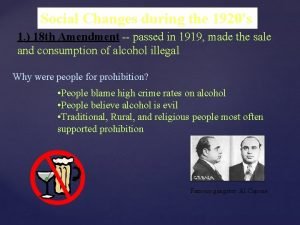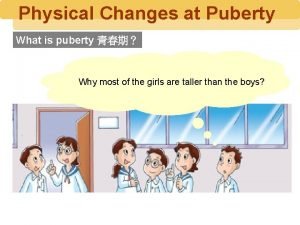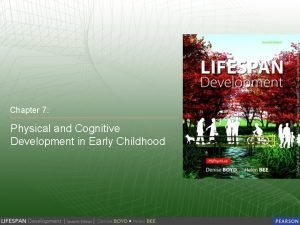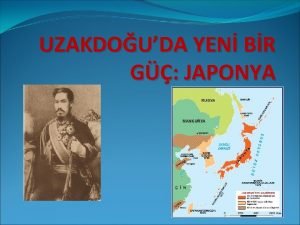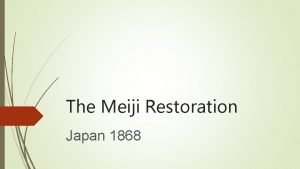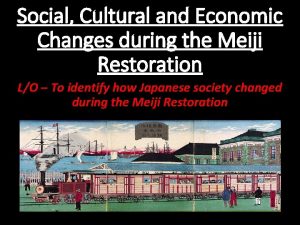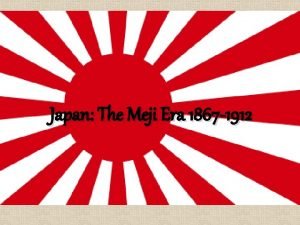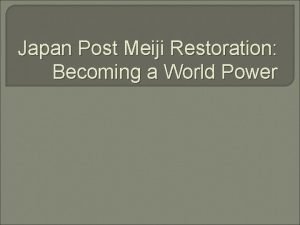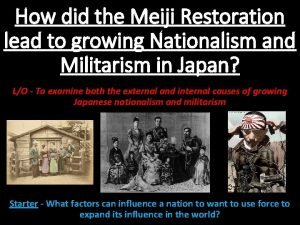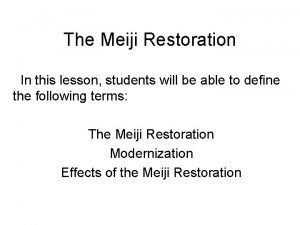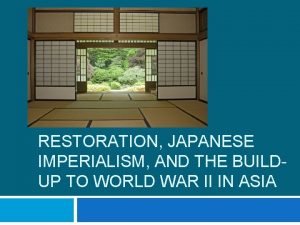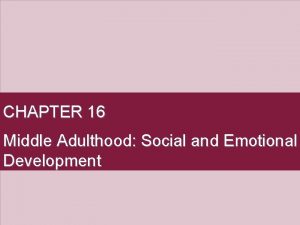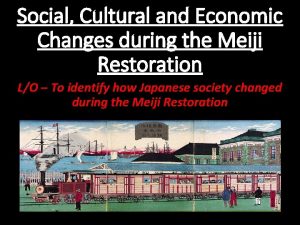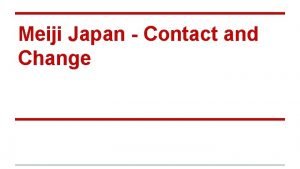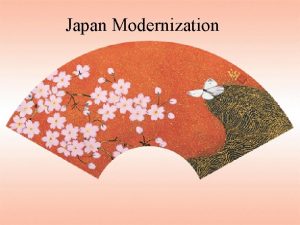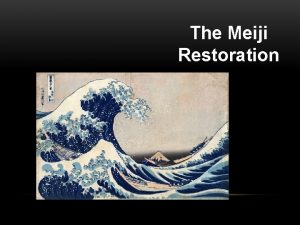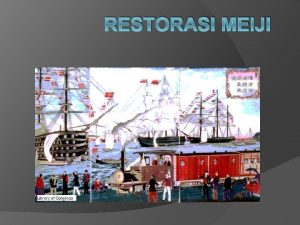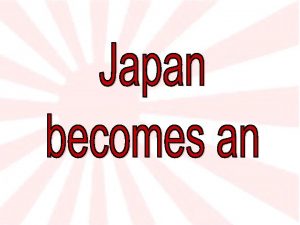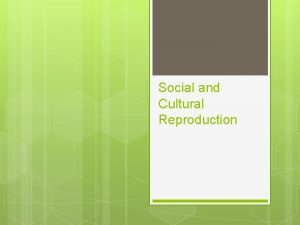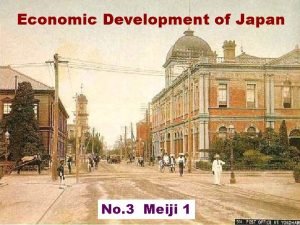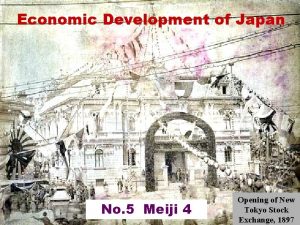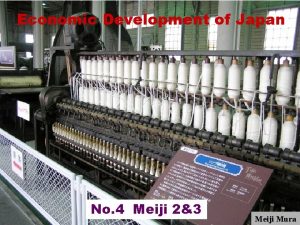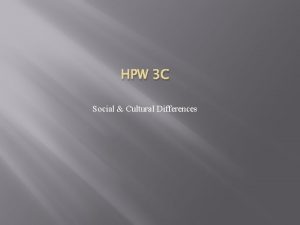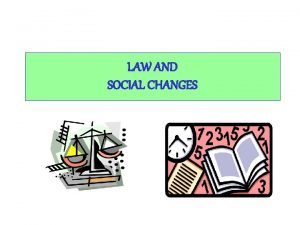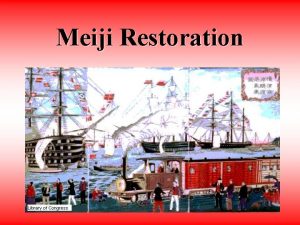Social Cultural and Economic Changes during the Meiji






























- Slides: 30

Social, Cultural and Economic Changes during the Meiji Restoration L/O – To identify how Japanese society changed during the Meiji Restoration

The Goal of the Meiji Reformers • The primary goal of the Meiji Reformers was to modernise Japan in order to end the unfair treaties imposed on it by the West. • Two study missions were sent to the West to find out how this could be done. First, the Iwakura Tomomi Iwakura Mission of 1872; Second, the Hirobumi Mission of 1882. Both reported the West’s power seemed to lie in its advanced science, economy and military. • Meiji reformers therefore coined the phrase ‘rich country, strong army’ (fukoku kyo nei) as an aim. Japan would have to be changed socially, culturally and economically in order to Ito Hirobumi achieve this.

Members of the Iwakura Misson (1872)

Route of the Iwakura Mission

Problems facing Meiji Reformers Social Problems Japan was divided socially by a rigid class/caste system known as the shi-no-ko-sho. Japan was a fixed, hereditary system. No incentive for people to improve their lives, reform or innovate. Cultural Problems Confucian belief system under In 1868 Japan had an advanced the Tokugawa Bakufu feudal economy but was still discouraged change to the social based on agriculture. Silk was its system and Westernisation. main export. Elements of society hostile to Westernisation and development. Samurai stipends amounted to Samurai culture and ‘Bushido’ 50% of government expenditure discouraged many Samurai from in 1871. adapting to modern warfare. No public school system in 1868. Women had no rights in society. Economic Problems Japanese national identity was still weak and many not committed to the emperor as a political symbol. No national tax system in 1868! Lack of government funds for development and industrialisation. Japanese industry faced foreign competition on unequal terms, unable to protect its own industries. Japan lacked raw materials for industrialisation.

Social Changes • One of the strangest things about the Meiji Restoration is the fact that the Samurai and Daimyo class abolished themselves! • In the 1870 s the government took incremental steps to reduced the power of the Samurai. • This was necessary in order to reform Japanese society from a hereditary status system to a meritocracy. This was necessary – Samurai stipends were costing the government 50% of public revenue!



The End of the Samurai • 1869 – Samurai ranks reduced to just two: Upper (shizoku) and Lower Samurai (sotsu). • 1872 – Large proportion of Lower Samurai reclassified as ‘commoners’ (heimin), although retain stipend. • 1873 – Stipends are taxed for first time. • 1873 – Mass Conscription to imperial army introduced. All males over 20 serve for 3 years. Samurai face loss of pride and purpose.

The End of the Samurai • 1874 – Voluntary program to convert Stipends to government bonds. Bonds promised 5 -15 years of income with 5 -7% interest. Lower than Stipend so few accepted. • 1876 – Bond program made compulsory. All Stipends converted to bonds. Samurai incomes fall by 10 -75%. Samurai also banned from carrying weapons – reserved for police and army only. • 1877 – Satsuma Rebellion. Last Samurai rebellion against reforms led by Saigo Takamori. Defeated by government.

Other Social Changes • 1870 – All non-Samurai in Japan were classified in legal terms as ‘commoners’ (heimin), ending the shinokosho system. • 1870 – Tokugawa restrictions on modes of travel, dress, hairstyle and occupation all ended. • 1870 – Discrimination against outcast groups such as eta and hinin ended. Reclassified as ‘burakumin’ or village people.


Changes to Education • If society was to change and modernise, the Meiji reformers knew that the education system also had to change. It was based on American and French models. • Like military conscription, mass schooling was seen as a source of the economic and military strength of the West. • 1872 – National system of elementary, middle school and university education established. 4 years compulsory elementary education.

Changes to Education • Schooling was to emphasise practical/technical learning and independent thinking. The school system was also used to teach children to be patriotic towards the emperor. • 1885 – 46% school attendance • 1900 – 90% school attendance • 1905 – 98% school attendance • Schooling enforced the idea that life should be open and reflect one’s talents and efforts i. e. meritocracy.

Cultural Changes - Westernisation • With social changes came cultural change. In the 1870 s there was a fashion for anything Western from Ball-room dancing to beards and top hats. • The catalyst for cultural changes was the publishing industry. Books, essays and novels all discussed Western Ideas, especially after the Iwakura Mission of 1872. • 1871 – First newspaper – Yokohama Mainichi • 1872 – Western style dress became obligatory at the Royal Court.

Cultural Changes – Eastern Spirit • However Japan didn’t just copy the West culturally. It based its new nationalism on Western ideas and a revival of its own past. • Shintoism was re-emphasised as the state religion and personified in the emperor and a new Shinto shrine for the nation was built in Tokyo – the Yasukuni Jinja. • Bushido (Way of the Samurai) was reinvented as the ‘Soul of Japan’: a new nationalist ideology. See Bushido: The Soul of Japan (1899).


Cultural Changes – Emperor Worship • This new Japanese nationalism, a mixture of Western ideas and Japanese traditions, was symbolised by the emperor himself. • The emperor became a unifying force for this new nationalism, and he came to represent the social and national identity of Meiji Japan. • This was reinforced by the 1889 Constitution, Patriotic Education in school and through the Shinto religion.

Economic Changes – Emperor Worship • Ever since the Iwakura Mission in 1872, the reformers realised that the source of Western strength came from their economic power: ‘Our recent travels have taken us to many interesting and famous places…there is nothing we have not visited. Everywhere you go there is nothing growing in the ground, just coal and iron… Factories have increased to an unheard-of extent, their black smoke rising to the sky… This is a sufficient explanation of England’s wealth and strength… and it is said that this great growth of trade and industry in the cities is something which has happened in the last fifty years. ’ Okubo Toshimichi, 20 th December 1872, four days after leaving Dover, UK. Okubo was deputy to the ambassador Iwakura Tomomi and was himself an ex -samurai.

Economic Changes – Financing Growth • The first problem was financing the government budget. In 1871, the government took on the debt of all the domains. Samurai costs reached 50% of total government expenditure. • By dismantling the privileges of the Daimyo and Samurai class, the government reduced costs. • 1873 – A National Land Tax was introduced for the first time, demanding cash payments instead of rice.

Economic Changes – Industrialisation • The government next used these funds to build new industries and ‘model factories’ for the business community to imitate. • Shipping lines, railways, telegraph and telephone systems, shipyards, mines, munition works and consumer industries like sugar, glass and cement were built. • However by the 1880 s, a lack of funds forced the government to sell these industries to private businesses. In return for working for the government, the companies would get special privileges.

Economic Changes – Industrialisation • This became known as the Zaibatsu system (huge business conglomerates) like Mitsubishi and Nintendo were created at this time. • Many Zaibatsu found it hard at first to compete internationally, so many companies sold their products at a loss to gain markets. • The Japanese Silk industry was one market in which they dominated, helped by the failure of the Italian Silk Market.

Raw Silk Production & Export from Japan 1868 -1913 Period Production annual average (tons) Exports annual average (tons) 1868 -1872 1026 646 1883 1687 1347 1889 -1893 4098 2444 1899 -1903 7103 4098 1909 -1913 12460 9462

Coal Production in Japan from 18751913 Period Coal Production (metric tons) 1875 600, 000 1885 1, 200, 000 1895 5, 000 1905 13, 000 1913 21, 300, 000

The Size of the Japanese Merchant Fleet from 1873 -1913 Period Number of Steamships 1873 26 1894 169 1904 797 1913 1514

Road Mileage in Japan from 1873 -1913 Period Track (miles) 1872 18 1883 240 1887 640 1894 2100 1904 4700 1914 7100

1. What does this source convey about how the Americans were perceived at this time in Japan?

2. When created, the cartoon in Source A would have been aimed at a European audience, What kind of image of the Japanese emperor do you think it was trying to convey?

3. Source B is a print of the Imperial Diet in 1890. What impression does this convey of the kind of body that governed Japan at this time?

Task You task is to write up your notes on the Social, Cultural and Economic changes of the Meiji Restoration. You can either: Produce a detailed timeline of the major changes Produce a comic strip of changes (Comic. Life 3? ) Produce a Youtube Video / Presentation of the Changes Create a revision booklet of the change Create a textbook style revision hand-out with pictures Any other method you see fit. Try to think of ways to record your information clearly and diagrammatically and with images. Read the articles on the website under ‘further reading’ for more information and notes.
 Social changes in the 1920s
Social changes in the 1920s Changes in latitudes, changes in attitudes meaning
Changes in latitudes, changes in attitudes meaning Chemical change definition
Chemical change definition What economic changes in the 1830s promoted german unity?
What economic changes in the 1830s promoted german unity? Cardiac cycle
Cardiac cycle Urethra
Urethra Physical development in adulthood
Physical development in adulthood Physical changes during childhood
Physical changes during childhood Economic growth vs economic development
Economic growth vs economic development Puritans england
Puritans england Meiji restorasyonu yenilikleri
Meiji restorasyonu yenilikleri Meiji restoration
Meiji restoration 5 element of national identity
5 element of national identity Shogunate
Shogunate Meiji restoration
Meiji restoration Latar belakang munculnya restorasi meiji
Latar belakang munculnya restorasi meiji Japan before meiji restoration
Japan before meiji restoration Meiji university ikuta campus
Meiji university ikuta campus Meiji restoration definition
Meiji restoration definition Define meiji restoration
Define meiji restoration Kao kunrenjo
Kao kunrenjo Economic growth vs economic development
Economic growth vs economic development Lesson 2 our economic choices
Lesson 2 our economic choices Cultural competence staircase
Cultural competence staircase Social thinking adalah
Social thinking adalah Social thinking social influence social relations
Social thinking social influence social relations Social changes in middle adulthood
Social changes in middle adulthood Middle adulthood socioemotional development
Middle adulthood socioemotional development Middle adulthood social changes
Middle adulthood social changes Social changes in adolescence
Social changes in adolescence Stages of human growth and development pictures
Stages of human growth and development pictures
